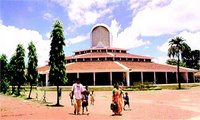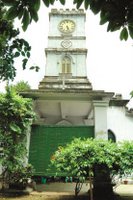Churches of Dhaka (original) (raw)
Churches of Dhaka
Gate of Church, old and new church (below)


Holy Rosary Church Dhaka: In the heart of Dhaka, on a vast area of land in Tejgaon that was allowed by the the then Mughal Subahder, stands the old building of the Holy Rosary Church, a parish cultivated by the Holy Cross Fathers and Sisters. It is believed to be the oldest church in the Indian sub-continent once known as 'The mother of Churches.' The inscription on the pinnacle of the old Church shows a date numerals 1677, built by the Portuguese Augustinian missionaries but many believe it was built in the 16th century. (In 1628, they established a church, called the ‘Church of the Assumption’, in Narinda, southern part of the Dhaka city. But the church doesn't exist this days). So this church is popularly known to be the oldest church of the city. In 1610, when Dhaka became the Mughal capital of Bengal, European and central Asian settlers came in numbers and built factories in Tejgaon area and later in old Dhaka and Farashganj. Traveler Sebastian Manrique and Travernier visiting Dhaka in the 17th century mentioned the church in their journals. The church measured 210' x 32' x 25' high built with brick and lime-surki on 12 massive columns depicting 12 disciples of Jesus. It had congregation capacity of 800-900.
In the early years of 17th century the Nestorian Christians built the western part as a chapel. The walls are 48 inch thick in this part. The eastern part is 83 feet and 6 inch long and 32 feet and 3 inch wide,the walls are 15 inch wide. There are 12 Tuscan columns holding the central nave from both side. The diameter of the columns is 3 feet. The church contains all the signs of a Basilican church . It has a main long rectangular hall consisting central nave and aisles in both side. It features Hindu, Muslim, Christian and regional architecture style. The church has 5 entries main entry is on east facade and the north and south facade has 2 entries each. The south and northern entries lack any porch. The north and south facade have 9 windows each.
The new church built recently is a large one covers 17,000 sft area and 50' high (91' dome height). It accommodate 1500 plus 500 in veranda. The architecture depicts sea shell in beach (baptism) and 3 slant roof (trinity) following local style.
The Holy Rosary Church premises houses one of the two Catholic cemeteries in Dhaka. More and more Catholics in the new part of Dhaka are buried here. Two schools belonged to this parish, Holy Cross College for the girls and Notrè Dame College for the boys.

Archbishop's House, Kakrail Dhaka: established in 1886 at 1 Kakrail Road, P.O. Box-3, Dhaka 1000, Bangladesh.
Baptist Church Sangha, Sadarghat
Hostel, Liaqat Av. Sadarghat
 St. Thomas Church, Dhaka: The official name of this Anglican Church, better known as the St. Thomas Church, is the 'Church of Bangladesh'. Built in 1819, and consecrated two years later by Bishop Reginald Heber of Kolkata (Calcutta), the church premise was in an area of lush greeneries with the famous Bahadur Shah park in a stones throw distance on the south. The north-south axial Nawabpur/Johnson Road, the most important commercial street connecting the old part of the city with the new, was on the west and separated the area from the court, Bank, DC's office and
St. Thomas Church, Dhaka: The official name of this Anglican Church, better known as the St. Thomas Church, is the 'Church of Bangladesh'. Built in 1819, and consecrated two years later by Bishop Reginald Heber of Kolkata (Calcutta), the church premise was in an area of lush greeneries with the famous Bahadur Shah park in a stones throw distance on the south. The north-south axial Nawabpur/Johnson Road, the most important commercial street connecting the old part of the city with the new, was on the west and separated the area from the court, Bank, DC's office and
buildings across it. In fact the church overlooking the greens was a major focal of the city centre in the nineteenth century.
It is said that the convicts from Dhaka Jail gave their labour to build this church as well. The attraction of this building, built after the style of the prevalent contemporary Indian Churches, is a clock tower. The rectangular flat-roof steeple rises above the roof in two stages. The arches over the doorway and windows are of Gothic style, while those of the main tower are pointed. The roof used wooden battens on iron joists; the floor have tiles. The delicate stone and brick works of this white plastered building are still as immaculate as it has been for nearly two centuries.


St. Gregory's Church, Laxmibazaar: Located opposite to the old Municipality Office at Laxmibazaar, this church was built in different stages. The original church of the order of the Holy Cross was erected in 1897 probably by a Belgian Father Gregory the Great. It was in French-Gothic style. But the original building collapsed in an earthquake that ravaged Bengal. Afterwards, it was rebuilt, converting the large back verandah into the main prayer hall. The church building, adjacent to the missionary school by the same name, has seven entrances on the west, each one crowned by Gothic arches and coloured glass skylights. The porch on the north-west corner carries a square belfry originally fitted with a clock.




The Armenian Church, Dhaka: The Armenian Church is a historically significant architectural monument situated in the Armanitola area of old Dhaka, Bangladesh. It was established by the Armenian community, to whose former existence the church bears testimony. It is one of the oldest constructions in this city and was built in 1781. The Armenians were rich influential business community. Armenian traders came to the Indian subcontinent in 12th century. After their ample success in trade, Mughal Emperor Akbar permitted them to preach. The area where they lived became known as Armanitola. The Armenian Church in old Dhaka was one of the meeting places for the orthodox Armenian Christians, who observe Christmas on January 7. In the mid-19th century, they numbered no more than about 40 families. Because of their close business ties with the
, many Armenians became rich '
' with palatial houses. The church in Armanitola, in the heart of the crowded old city is known an oasis of tranquility. Twice a year the Armenian Archbishop from Australia comes here to hold ceremonies. Mother Teresa during her visit to Dhaka in 1996, stayed in this compound. The Church has a chapel with a balcony and the original wooden seat for 100 people. The ground cover nearly a hectare and is paved with 350 old graves stones, some quite ornately carved. Judging by the ages of those buried here, it seems that the local climate suit the Armenians.


